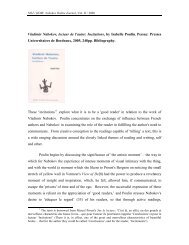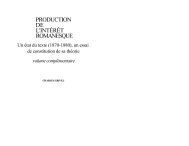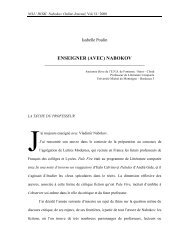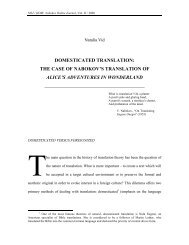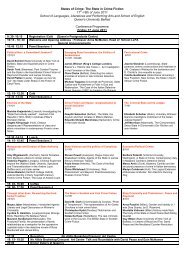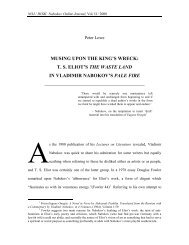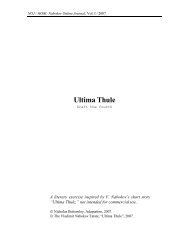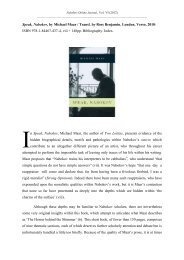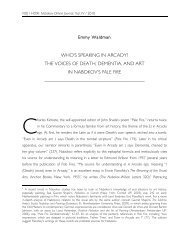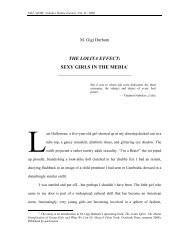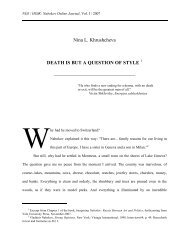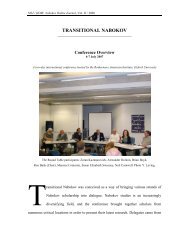Create successful ePaper yourself
Turn your PDF publications into a flip-book with our unique Google optimized e-Paper software.
Nabokov Online Journal, Vol. V (2011)<br />
_______________________________________________________________________<br />
3) As Pera herself admits, she is a (willfully) bad reader of Nabokov’s story.<br />
Disappointing Nabokov’s hope for an implied ideal reader who will understand his<br />
encoding of the text and enjoy the aesthetic experience it affords, Pera takes the story, as<br />
she puts it, “at face value.” Her removal of Nabokov’s characters, again in Pera’s words,<br />
“out of Nabokov’s world ”19 entails a travestying 20 thereof, as is readily seen in Lo’s<br />
killing of small animals and Humbert’s toothless mouth. Humbert and Lolita appear<br />
differently at different points in Nabokov’s novel; Pera’s characters, on the other hand,<br />
are static and two-dimensional, the traits suggested by Humbert’s narrative now exhibited<br />
in caricaturishly hyperbolic form. Pera’s Lo is an exact reproduction of the image<br />
Humbert creates at his worst moments, those when his aestheticism and curiosity are at<br />
their nadir and his self-deception and egoism their zenith. This skin-deep, two-<br />
dimensional portrayal of the girl renders any self-realization on the part of an artist, any<br />
epiphanic coming-to-terms with the mysterious subjectivity and autonomy of Lolita,<br />
completely impossible, for this Lo lacks the depth that would make her immortalization<br />
either attainable or worthwhile. In Pera’s Lo there is neither “garden,” nor “twilight,” nor<br />
“palace gate”; there are no “dim and adorable regions which happened to be lucidly and<br />
absolutely forbidden to” Humbert and to us, his readers. All that remains are “awful<br />
juvenile clichés.” 21 Moreover, Lo’s vulgarity and cynicism do not appear as the result of<br />
Humbert’s violation, but exist a priori. In creating such a brash Lo, Pera disempowers<br />
Humbert. Her purpose is to show that Humbert is powerless to deprave and destroy, or by<br />
19 As Pera told a lecture audience, “I incarnate [Nabokov’s] bad reader, a character who takes the story at<br />
face value and takes on a life of her own. I take Lolita out of Nabokov’s world” (quoted in Manus).<br />
20 The “elaborative type,” as mentioned at the beginning of this essay, is not uncommon; twentieth- and<br />
twenty first-century examples of the borrowing of literary characters and retelling of plots from their<br />
perspective include Tom Stoppard’s Rosencrantz and Guildenstern Are Dead, Michael Cunnigham’s The<br />
Hours, and Alice Randall’s The Wind Done Gone. One wonders whether the vituperation the “elaboration”<br />
occasionally elicits, as in the case of Lo’s Diary, is due to a kind of unspeakable crisis of origin. That is,<br />
characters in the “elaboration” are like clones, replicating their originals in form, but diverging from them<br />
in substance. And objections to the existence of clone characters in literature have their analogies to<br />
arguments against the cloning of humans; there is the religious argument (the author is a God, the imitation<br />
of whom constitutes “satanic pride”); the medical-cautionary one, warning of the possible defects pursuant<br />
to tinkering with genetics/origins; and the secular/ethical objection that cloning of people/characters might<br />
reduce their uniqueness.<br />
21 Nabokov’s text reads: “I simply did not know a thing about my darling’s mind and ... quite possibly,<br />
behind the awful juvenile clichés, there was in her a garden and a twilight, and a palace gate – dim and<br />
adorable regions which happened to be lucidly and absolutely forbidden to me, in my polluted rags and<br />
miserable convulsions” (284).<br />
15



